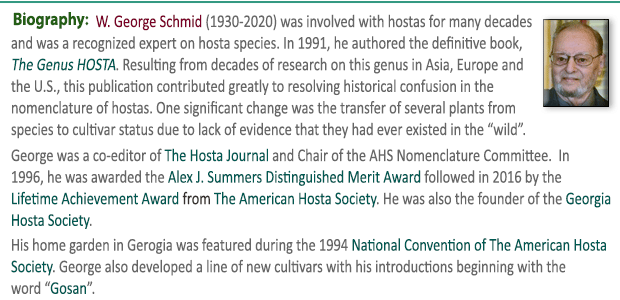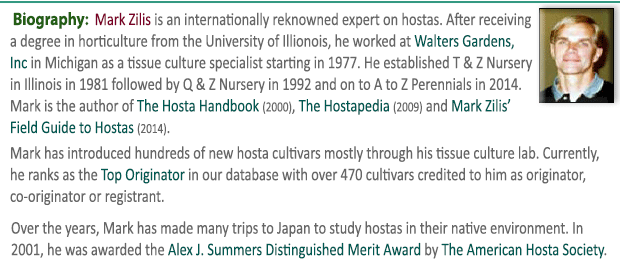|
  Originally from Korea, this species has slightly wavy,
green, heart shaped leaves which are pinched at the squarish
base. It is a miniature size (about 6 inches high by 20 inches
wide) plant, forming a dense mound. The
lavender flowers with darker veins and purple/yellow anthers appear from late June into July. Due to its size,
H. venusta and its cultivars are favorites in
rock gardens and in the front of beds and borders. Originally from Korea, this species has slightly wavy,
green, heart shaped leaves which are pinched at the squarish
base. It is a miniature size (about 6 inches high by 20 inches
wide) plant, forming a dense mound. The
lavender flowers with darker veins and purple/yellow anthers appear from late June into July. Due to its size,
H. venusta and its cultivars are favorites in
rock gardens and in the front of beds and borders.
The Genus Hosta by W. George Schmid (1991), says that this species is known as the "(beautiful)
maiden hosta" in its native Korea.
H. gracillima is sometimes
confused with H. venusta "...but the flowering scape of
H. gracillima is smooth while that of
H. venusta
has ridges, and this difference can serve as a positive
identifier."
 From the
Field Guide to Hostas by Mark Zilis (2014), "To many hosta collectors, H. venusta ranks as the top mini
species." From the
Field Guide to Hostas by Mark Zilis (2014), "To many hosta collectors, H. venusta ranks as the top mini
species."
The New Encyclopedia of Hostas by
Diana
Grenfell (2009) states in its Miniature Hostas chapter: "A variable
species in leaf size and shape. More suitable for small
containers and rock gardens than a border, where it is likely to
become swamped by larger plants."
This cultivar has been awarded the Royal Horticultural
Society's Award of Garden Merit in the
UK.
Mikiko Lockwood in an article on The Hosta Library titled,
A Little About Japanese Hosta Terms defines the term otome as maiden, 'Otome Gibōshi' or
H. venusta.

 A Photo Essay article by Steve Chamberlain in
The
Hostta Journal (2010 Vol. 41 No. 1) makes comments about
H. venusta, "This is the
smallest hosta species. Wild-collected examples of
H. venusta vary considerably in size and appearance from this clone, which is the
one widely available in commerce...tends to form a carpet rather than a clump as
it matures." A Photo Essay article by Steve Chamberlain in
The
Hostta Journal (2010 Vol. 41 No. 1) makes comments about
H. venusta, "This is the
smallest hosta species. Wild-collected examples of
H. venusta vary considerably in size and appearance from this clone, which is the
one widely available in commerce...tends to form a carpet rather than a clump as
it matures."
An article by Glenn Herold in
The
Hosta Journal (2014 Vol. 45 No. 1) states
that, "Korea has eight native hosta species:
Hosta capitata,
H. clausa,
H. jonesii, H. laevigata,
H. minor,
H. tsushimensis,
H. venusta and
H . yingeri.
H. laevigata is closely related to H. yingeri, H. minor is closely related to H. venusta, and
H. tsushimensis is closely related to H. jonesii."
|
 |
 |
|
|
"Most on
the original list are BIG hostas. What
is wrong with the tiny ones? I am
surprised this one did not show up in
the original list. It is very popular
and everyone seems to have a clump. Not
showy, perhaps, but neat and unique...It
will multiply fast and make a nice
ground cover. The flowers are lovely and
there are many." |
|
|
|
|
In answer to a question about growing smaller hostas that appeared in
The
Hosta Journal (2012 Vol. 43 No. 2),
W. George Schmid
of Georgia, author of
The Genus Hosta (1991) commented, "My favorite minis are
H. venusta,
H. gracillima, a white-margined sport of
H. gracillima named 'Kifukurin
Ko Mame', H. pulchella and 'Blue Mouse Ears' ." |






 |



